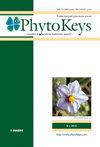Advances in Legume Systematics 14. Classification of Caesalpinioideae. Part 2: Higher-level classification
IF 1.3
3区 生物学
Q3 PLANT SCIENCES
引用次数: 0
Abstract
Caesalpinioideae is the second largest subfamily of legumes (Leguminosae) with ca. 4680 species and 163 genera. It is an ecologically and economically important group formed of mostly woody perennials that range from large canopy emergent trees to functionally herbaceous geoxyles, lianas and shrubs, and which has a global distribution, occurring on every continent except Antarctica. Following the recent re-circumscription of 15 Caesalpinioideae genera as presented in Advances in Legume Systematics 14, Part 1, and using as a basis a phylogenomic analysis of 997 nuclear gene sequences for 420 species and all but five of the genera currently recognised in the subfamily, we present a new higher-level classification for the subfamily. The new classification of Caesalpinioideae comprises eleven tribes, all of which are either new, reinstated or re-circumscribed at this rank: Caesalpinieae Rchb. (27 genera / ca. 223 species), Campsiandreae LPWG (2 / 5–22), Cassieae Bronn (7 / 695), Ceratonieae Rchb. (4 / 6), Dimorphandreae Benth. (4 / 35), Erythrophleeae LPWG (2 /13), Gleditsieae Nakai (3 / 20), Mimoseae Bronn (100 / ca. 3510), Pterogyneae LPWG (1 / 1), Schizolobieae Nakai (8 / 42–43), Sclerolobieae Benth. & Hook. f. (5 / ca. 113). Although many of these lineages have been recognised and named in the past, either as tribes or informal generic groups, their circumscriptions have varied widely and changed over the past decades, such that all the tribes described here differ in generic membership from those previously recognised. Importantly, the approximately 3500 species and 100 genera of the former subfamily Mimosoideae are now placed in the reinstated, but newly circumscribed, tribe Mimoseae. Because of the large size and ecological importance of the tribe, we also provide a clade-based classification system for Mimoseae that includes 17 named lower-level clades. Fourteen of the 100 Mimoseae genera remain unplaced in these lower-level clades: eight are resolved in two grades and six are phylogenetically isolated monogeneric lineages. In addition to the new classification, we provide a key to genera, morphological descriptions and notes for all 163 genera, all tribes, and all named clades. The diversity of growth forms, foliage, flowers and fruits are illustrated for all genera, and for each genus we also provide a distribution map, based on quality-controlled herbarium specimen localities. A glossary for specialised terms used in legume morphology is provided. This new phylogenetically based classification of Caesalpinioideae provides a solid system for communication and a framework for downstream analyses of biogeography, trait evolution and diversification, as well as for taxonomic revision of still understudied genera.豆科植物系统学的进展 14.Caesalpinioideae 的分类。第 2 部分:高层分类
豆科植物亚科(Caesalpinioideae)是豆科植物(豆科)的第二大亚科,约有 4680 个种和 163 个属。它是一个在生态和经济上都很重要的类群,主要由多年生木本植物组成,从树冠高大的乔木到功能性草本地衣、藤本植物和灌木,其分布范围遍及全球,除南极洲外,各大洲都有分布。最近,《豆科系统学进展 14》(Advances in Legume Systematics 14)第一部分对 15 个 Caesalpinioideae 属进行了重新划分,并以对 420 个物种和目前亚科中除 5 个属之外的所有其他属的 997 个核基因序列进行的系统发生组分析为基础,我们提出了亚科新的高级分类法。Caesalpinioideae 的新分类包括 11 个支系,所有支系都是新的、恢复的或重新划分的:Caesalpinieae Rchb.(27 属 / 约 223 种)、Campsiandreae LPWG(2 / 5-22)、Cassieae Bronn(7 / 695)、Ceratonieae Rchb.(4 / 35), Erythrophleeae LPWG (2 / 13), Gleditsieae Nakai (3 / 20), Mimoseae Bronn (100 / ca. 3510), Pterogyneae LPWG (1 / 1), Schizolobieae Nakai (8 / 42-43), Sclerolobieae Benth. & Hook. f. (5 / ca. 113).尽管这些支系中的许多支系在过去已被确认和命名为部落或非正式的属群,但在过去的几十年中,它们的范围变化很大,因此这里描述的所有部落在属群成员组成上都与以前确认的部落不同。重要的是,前含羞草亚科(Mimosoideae)的约 3500 个种和 100 个属现在被归入恢复的、但新划分的含羞草科(Mimoseae)。由于该族的庞大规模和生态重要性,我们还为含羞草科提供了一个基于支系的分类系统,其中包括 17 个命名的低级支系。在 100 个含羞草属中,有 14 个仍未归入这些低级支系:其中 8 个支系分为两个等级,6 个支系在系统发育上是孤立的单属。除了新的分类法之外,我们还为所有 163 个属、所有科和所有命名的支系提供了属键、形态描述和注释。所有属的生长形态、叶片、花和果实的多样性都有图解,我们还根据质量受控的标本馆标本地点,为每个属提供了分布图。我们还提供了豆科植物形态学专业词汇表。这一新的基于系统发生学的豆科植物分类法为生物地理学、性状进化和多样化的下游分析以及仍未得到充分研究的属的分类修订提供了一个坚实的交流系统和框架。
本文章由计算机程序翻译,如有差异,请以英文原文为准。
求助全文
约1分钟内获得全文
求助全文
来源期刊

PhytoKeys
PLANT SCIENCES-
CiteScore
2.60
自引率
14.30%
发文量
189
审稿时长
6 weeks
期刊介绍:
PhytoKeys is a peer-reviewed, open-access, online and print, rapidly produced journal launched to support free exchange of ideas and information in systematic botany.
All papers published in PhytoKeys can be freely copied, downloaded, printed and distributed at no charge for the reader. Authors are thus encouraged to post the pdf files of published papers on their homepages or elsewhere to expedite distribution. There is no charge for color.
 求助内容:
求助内容: 应助结果提醒方式:
应助结果提醒方式:


